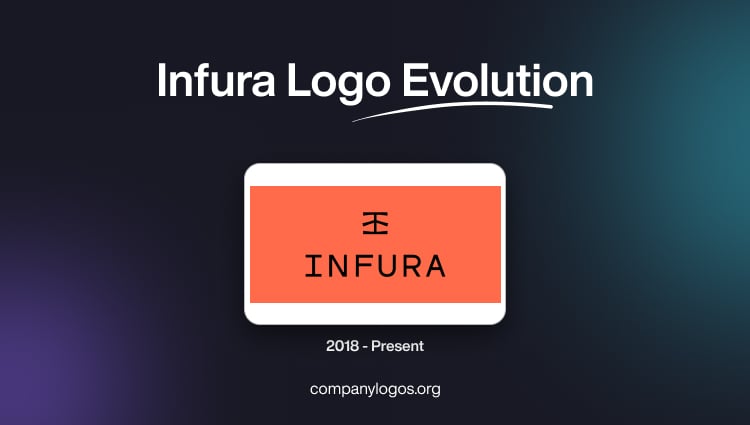
Infura is a leading blockchain infrastructure provider that enables developers to seamlessly connect their applications to Ethereum and other decentralised networks without the need to run their own nodes. It was founded in 2016 and incubated under ConsenSys and has since grown into one of the most essential services in the Web3 ecosystem. It powers everything from wallets and decentralised finance (DeFi) platforms to NFT marketplaces and enterprise blockchain solutions. The article explores the evolution of the Infura logo over the years, among other details of the company.
The Genesis of the Infura Logo (2016 – 2017) (Unavailable)
The original Infura logo was more playful in its imagery rather than being polished and sophisticated. The logo included a Godzilla-style motif as its thematic branding. In fact, the logo was less about a formal wordmark and more about illustrative art. It emphasised spirit and aimed at an audience comprising developers.
(2018 – Present)
In 2018, Infura introduced a new visual identity that was created in partnership with Brooklyn design studio Relative. There was a compact icon based on a simplified “I” transformed into a navigational symbol. Alongside the “I” motif appeared the brand name in uppercase and executed using a clean, bold, and geometric sans-serif typeface.

The Elements of the Infura Logo
Font
The wordmark used in the Infura logo is written using a clean, bold, and geometric sans-serif typeface in uppercase. The font is similar to modern grotesque or neo-grotesque typefaces.
Colour
The colours used in designing the Infura logo are orange, white, and black. Here, the colour orange symbolises innovation, accessibility, and energy. The black and white colours, on the other hand, are used for better contrast and maximum visibility.
The History of Infura
Infura was founded in 2016 by E.G. Galano and Michael Godsey as part of the Ethereum ecosystem. It was incubated under ConsenSys, the Ethereum-focused venture studio created by Joseph Lubin. The initial idea was to provide developers with reliable, scalable access to the Ethereum blockchain without the complexity of running their own full nodes.
At a time when Ethereum was still new and infrastructure tools were limited, Infura addressed one of the biggest developer pain points, that is, the difficulty of setting up and maintaining Ethereum nodes. By offering a hosted API and gateway to Ethereum, Infura quickly became a vital backbone for dapp developers.
During Ethereum’s first big wave of adoption in 2017, the demand for Infura skyrocketed. In fact, popular decentralised applications like MetaMask, CryptoKitties, and Uniswap relied on Infura to connect users to the Ethereum network. By 2017, Infura was already processing billions of requests per day. Its reliability made it the go-to infrastructure for developers launching ICOs, gaming dapps, and DeFi experiments. In 2018, Infura officially launched a major rebrand, which reflected its new role as a trusted provider of production-grade infrastructure rather than just a developer experiment.
In October 2019, Infura was formally consolidated under the ConsenSys umbrella. In doing so, it further strengthened its ties with other Ethereum infrastructure projects such as MetaMask and Truffle. As Ethereum usage exploded with the growth of DeFi (Decentralised Finance) in 2020 and NFTs in 2021, Infura played a silent but critical role in powering the backend of countless applications. In fact, its infrastructure was scaled to handle tens of billions of requests per day. This ensured dapps to function smoothly during times of network congestion.
Infura became known as “Ethereum’s backbone”, a trusted service provider that underpinned much of Web3 activity without most users even realising it. While originally designed for Ethereum, Infura began expanding to support multiple blockchains as Web3 matured. Developers wanted multi-chain infrastructure, and Infura responded by broadening its platform.
By 2022, Infura offered services for a host of blockchain-based platforms, such as Ethereum, Polygon, Optimism, Arbitrum, BNB Smart Chain, Avalanche C-Chain, and Near Protocol. This move signalled the shift made by Infura from being purely an Ethereum provider to becoming a multi-chain infrastructure gateway for Web3 developers.
To address long-standing concerns about centralisation (since Infura’s infrastructure was operated by a single entity under ConsenSys), the team announced the creation of the Infura Decentralised Network (INFURA Network). This network would allow multiple providers to operate under a decentralised infrastructure layer. Besides, it would help improve resilience, censorship resistance, and trust. The aim is to ensure that developers continue to have reliable blockchain access while reducing dependence on a single provider.
Interesting Facts About Infura
- Infura is often called the “backbone of Ethereum” because thousands of dApps and wallets (including MetaMask, Uniswap, and MakerDAO) rely on it for blockchain access.
- Many users of these applications interact with Ethereum every day without realising they are actually using Infura behind the scenes.
- Infura handles tens of billions of requests per day from around the world.
- During peak times (such as major DeFi launches or NFT drops), Infura’s infrastructure is scaled to handle massive spikes in traffic.
- Since running a full Ethereum node is technically complex and resource-intensive, Infura provided an instant API gateway. It allows developers to connect to Ethereum in minutes instead of weeks.
- Infura is deeply integrated with MetaMask, which is the most widely used Ethereum wallet. By default, MetaMask connects to the Ethereum blockchain through Infura’s infrastructure.
- In its early days, Infura’s branding was themed around the imagery of Godzilla before its professional rebranding in 2018. This playful identity reflected its hacker/developer community roots.
- Infura is a core infrastructure product under ConsenSys, the Ethereum-focused company founded by Joseph Lubin (one of Ethereum’s original co-founders).
- Its sibling products include MetaMask and Truffle, which helped Infura to create a powerful developer ecosystem.
- While Infura started with Ethereum, it now supports multiple blockchains, including Polygon, Arbitrum, Optimism, Avalanche, BNB Smart Chain, and Near. This makes it a multi-chain infrastructure gateway for Web3.
- To address concerns about centralisation, Infura is working on a decentralised network model where multiple providers contribute infrastructure. This aims to make access more resilient and censorship-resistant.
- Infura has been tested during high-profile events like the CryptoKitties craze in 2017, the DeFi summer of 2020, and the NFT boom in 2021.
- Beyond dApps, Infura also provides blockchain infrastructure for enterprises and institutions exploring Ethereum-based solutions.
Finally
The evolution of the Infura logo reflects how a product-heavy technical startup changes its brand as it scales. In other words, from idiosyncratic, community-facing motifs, the logo acquired a focused, systemised identity that communicates reliability, fits product ecosystems and supports co-branding. The 2018 redesign was the defining moment to establish that identity. From then, the mark has been refined and deployed at scale.